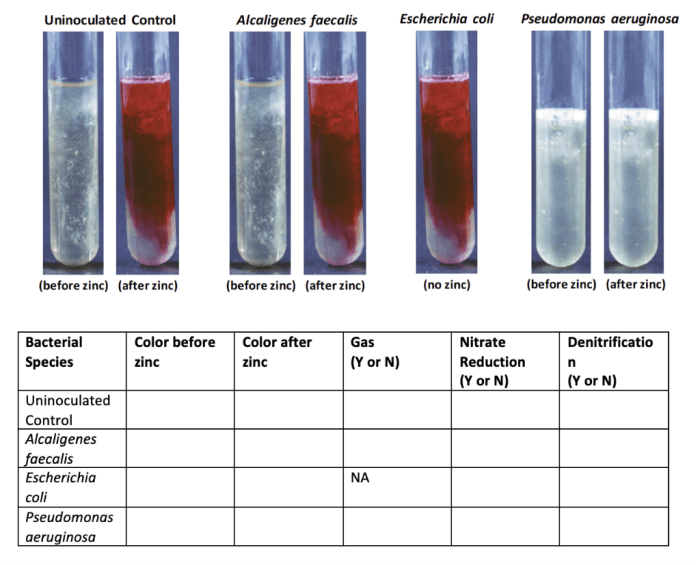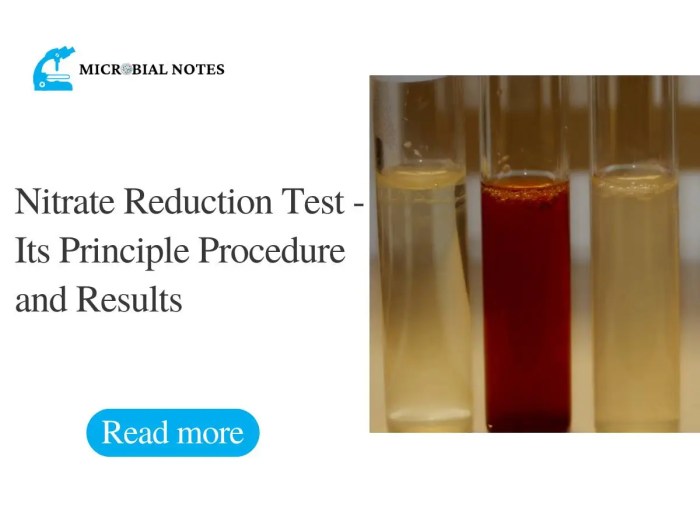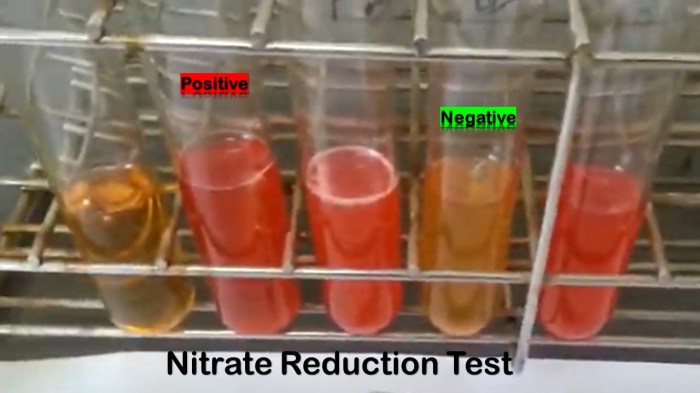P aeruginosa nitrate reduction test – The P. aeruginosa nitrate reduction test, a cornerstone in microbiology, stands as a vital tool for identifying this ubiquitous bacterium. This test, by harnessing the biochemical capabilities of P. aeruginosa, offers insights into its physiology and aids in the diagnosis of infections.
Join us as we delve into the intricacies of this test, exploring its applications, principles, and significance.
The nitrate reduction pathway in P. aeruginosa, catalyzed by the enzyme nitrate reductase, serves as the foundation of this test. This pathway enables the bacterium to utilize nitrate as an alternative electron acceptor under anaerobic conditions. The presence or absence of nitrate reductase activity, detected through the accumulation of nitrite, forms the basis for interpreting the test results.
Introduction

The Pseudomonas aeruginosa nitrate reduction test is a significant microbiological assay used to determine the ability of the bacterium Pseudomonas aeruginosa to reduce nitrate (NO3-) to nitrite (NO2-) and subsequently to nitrogen gas (N2). This test is crucial for identifying P.
aeruginosa in clinical and environmental settings and has applications in understanding the bacterium’s metabolism and pathogenesis.
Purpose and Applications
The nitrate reduction test serves several purposes and finds applications in various fields:
- Identification of P. aeruginosa:The test is a key characteristic for identifying P. aeruginosa, as most strains of this bacterium possess the ability to reduce nitrate. This identification is essential in clinical microbiology for diagnosing P. aeruginosa infections and implementing appropriate treatment strategies.
- Understanding P. aeruginosa Metabolism:The nitrate reduction test provides insights into the metabolic capabilities of P. aeruginosa. The bacterium’s ability to reduce nitrate indicates the presence of specific enzymes and metabolic pathways involved in anaerobic respiration. Understanding these metabolic processes is crucial for studying the bacterium’s survival and adaptation in diverse environments.
- Environmental Microbiology:In environmental microbiology, the nitrate reduction test is employed to assess the presence and activity of P. aeruginosa in various ecosystems. The bacterium’s ability to reduce nitrate can influence nitrogen cycling and contribute to the overall functioning of microbial communities in soil, water, and wastewater environments.
Principle of the Test
Biochemical Pathway of Nitrate Reduction
Nitrate reduction in P. aeruginosais a stepwise process involving the sequential reduction of nitrate (NO 3–) to nitrite (NO 2–), nitric oxide (NO), and finally nitrous oxide (N 2O).
The pathway is catalyzed by a series of enzymes, including nitrate reductase, nitrite reductase, and nitric oxide reductase.
Role of Nitrate Reductase Enzyme and its Regulation
Nitrate reductase is the key enzyme in the nitrate reduction pathway. It is a molybdenum-containing enzyme that catalyzes the reduction of nitrate to nitrite.
The activity of nitrate reductase is regulated by a variety of factors, including the availability of oxygen and nitrate, as well as the presence of specific regulatory proteins.
Under aerobic conditions, nitrate reductase is repressed by the presence of oxygen. This repression is mediated by the Fnr protein, which binds to the promoter region of the nitrate reductase gene and prevents its transcription.
Under anaerobic conditions, when oxygen is limiting, nitrate reductase is derepressed and its activity is increased. This derepression is mediated by the NarL protein, which binds to the Fnr protein and prevents it from repressing nitrate reductase gene transcription.
Procedure: P Aeruginosa Nitrate Reduction Test
The nitrate reduction test is a simple and inexpensive test used to differentiate between bacteria that can and cannot reduce nitrate to nitrite.
The test is performed by inoculating a bacterial culture into a nitrate broth medium and incubating the culture for 24-48 hours. After incubation, the culture is tested for the presence of nitrite using a nitrite reagent. If nitrite is present, the test is considered positive, indicating that the bacteria can reduce nitrate.
Reagents
- Nitrate broth medium
- Nitrite reagent
Bacterial Cultures
- A pure culture of the bacteria to be tested
Incubation Conditions
- Incubate the culture at 37°C for 24-48 hours.
Observation Methods, P aeruginosa nitrate reduction test
- After incubation, add a few drops of nitrite reagent to the culture.
- A positive test is indicated by the development of a red color.
Interpretation of Results

The nitrate reduction test differentiates between P. aeruginosaand other Pseudomonasspecies based on their ability to reduce nitrate to nitrite.
Positive Result
A positive nitrate reduction test indicates that the bacteria can reduce nitrate to nitrite. This is evident by the presence of a red color in the test tube, which indicates the presence of nitrite.
A positive result for the nitrate reduction test is a presumptive identification for P. aeruginosa. However, further biochemical tests are necessary to confirm the identification.
Negative Result
A negative nitrate reduction test indicates that the bacteria cannot reduce nitrate to nitrite. This is evident by the absence of a red color in the test tube.
A negative result for the nitrate reduction test suggests that the bacteria is not P. aeruginosa. However, it does not definitively rule out the possibility of P. aeruginosainfection, as some strains may have lost the ability to reduce nitrate.
Limitations and Potential Sources of Error
The nitrate reduction test has some limitations and potential sources of error:
- The test may not be able to differentiate between P. aeruginosaand other Pseudomonasspecies that have lost the ability to reduce nitrate.
- The test may be affected by the presence of other bacteria in the sample.
- The test may be affected by the temperature and pH of the medium.
Clinical Applications
The nitrate reduction test finds significant application in the clinical setting as a valuable tool for identifying P. aeruginosain clinical samples. This test aids in differentiating P. aeruginosafrom other closely related species, such as Pseudomonas fluorescens, which do not possess the ability to reduce nitrate.
Diagnostic Microbiology
In diagnostic microbiology, the nitrate reduction test is commonly employed to:
- Confirm the identification of P. aeruginosaisolates from clinical specimens, such as sputum, urine, or wound swabs.
- Differentiate P. aeruginosafrom other non-fermenting Gram-negative bacteria, such as Acinetobacter baumanniiand Stenotrophomonas maltophilia, which are typically nitrate-negative.
- Assist in the identification of P. aeruginosain mixed bacterial infections, where distinguishing between multiple species is crucial for appropriate antimicrobial therapy.
The nitrate reduction test provides valuable information in clinical microbiology laboratories, aiding in the accurate identification and characterization of P. aeruginosa, a significant opportunistic pathogen associated with a wide range of infections, including pneumonia, urinary tract infections, and bloodstream infections.
Research Applications

The nitrate reduction test has proven valuable in research studies, offering insights into the physiology and metabolism of P. aeruginosa.The test allows researchers to investigate the metabolic pathways utilized by P. aeruginosaunder various conditions, including nutrient availability and oxygen concentration. By analyzing the presence or absence of nitrite, researchers can determine whether the bacterium is capable of reducing nitrate to nitrite and further to ammonia.
This information aids in understanding the bacterium’s ability to adapt to different environments and its role in nitrogen cycling.
Examples of Research Projects
Numerous research projects have employed the nitrate reduction test to study P. aeruginosa. For instance, one study utilized the test to examine the effect of iron limitation on the bacterium’s metabolism. The results revealed that under iron-limiting conditions, P. aeruginosaexhibited an increased capacity for nitrate reduction, suggesting a shift in metabolic pathways to compensate for iron scarcity.Another
research project employed the nitrate reduction test to investigate the role of P. aeruginosain the denitrification process in soil. The study demonstrated that the bacterium could significantly contribute to soil denitrification, highlighting its ecological importance in nitrogen cycling.The nitrate reduction test has emerged as a versatile tool in research, providing valuable insights into the physiology, metabolism, and environmental roles of P. aeruginosa. Ongoing research continues to explore the multifaceted aspects of this bacterium, utilizing the nitrate reduction test as a key investigative method.
Additional Considerations
Additional factors must be considered to ensure accurate identification of P. aeruginosausing the nitrate reduction test.
Other Methods for Identifying P. aeruginosa
Several other methods can be employed to identify P. aeruginosa, including:
- Gram staining
- Oxidase test
- Catalase test
- Pyocyanin production
- Molecular techniques (e.g., PCR, sequencing)
Comparison of Nitrate Reduction Test to Other Methods
The nitrate reduction test is a simple and inexpensive method for identifying P. aeruginosa, but it has some limitations:
- Not all strains of P. aeruginosaare nitrate-reducing.
- Other bacteria, such as Alcaligenes faecalisand Burkholderia cepacia, can also reduce nitrate.
Importance of Quality Control Measures
Quality control measures are essential to ensure the accuracy of the nitrate reduction test. These measures include:
- Using a known positive control strain (e.g., P. aeruginosaATCC 27853)
- Using a known negative control strain (e.g., Escherichia coliATCC 25922)
- Following the test procedure carefully
- Interpreting the results correctly
FAQ Resource
What is the significance of the P. aeruginosa nitrate reduction test?
The P. aeruginosa nitrate reduction test is a valuable tool for identifying P. aeruginosa, a bacterium commonly associated with infections in healthcare settings. It aids in differentiating P. aeruginosa from other non-fermenting Gram-negative bacteria, contributing to accurate diagnosis and appropriate treatment.
How is the nitrate reduction test performed?
The test involves inoculating a bacterial culture into a nitrate broth medium and incubating it under anaerobic conditions. The presence of nitrate reductase enzyme is indicated by the accumulation of nitrite, which can be detected using specific reagents.
What are the limitations of the nitrate reduction test?
While the nitrate reduction test is generally reliable, certain factors can affect its accuracy. These include the age of the culture, the presence of inhibitors in the sample, and the incubation conditions. Quality control measures are crucial to ensure the test’s validity.